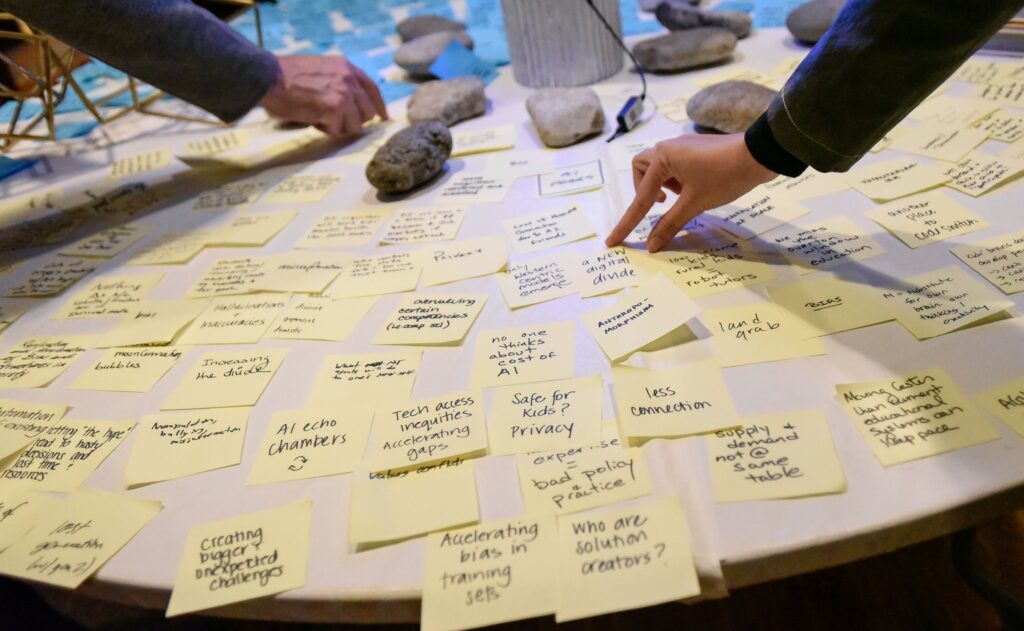
Participants at the Think Forward: Learning with AI forum in April were asked to share their hopes and fears for the future of AI in an opening exercise.
CREDIT: Photo by Ray Mares Photography
In recent months, the Los Angeles Unified School District (LAUSD) faced a significant setback when the tech provider it contracted to build personalized report cards for students went out of business. This was both a major financial loss for the district and a significant loss for students. The chatbot dust-up underscores a critical issue in our education system: the need for robust, forward-thinking policies and practices to navigate the integration of technology in our schools. Our school systems must be able to not only withstand disruptions but thrive on them.
As post-pandemic learning gaps widen, school districts everywhere are at an inflection point when it comes to the use of artificial intelligence (AI). AI offers unprecedented opportunities to tackle complex challenges like widening achievement gaps, teacher shortages, and mental health crises among students — but AI systems must also promote equity and access, particularly for historically marginalized communities. There must be policy guardrails to protect student privacy. And there must be high quality training to empower educators. Achieving this vision requires bold leadership and a clear understanding of each stakeholder’s role.
While AI can be a powerful tool to address long-standing inequities and improve educational outcomes, it requires strategic and collaborative efforts. The call to action is clear: Educators, policymakers, education technology innovators and community leaders must join forces to create resilient, adaptable education systems.
With a thriving tech sector, including a broad base of AI startups, California is uniquely positioned to lead the country in the use of AI in education. The state Department of Education has already offered early guidance to schools. The Los Angeles County Office of Education’s cross-sector task force developed guidelines to support responsible AI implementation across 80 school districts. Los Angeles’ Da Vinci Academy piloted the use of AI in project-based learning. Lynwood Unified has been a leader in thinking about how AI can be used responsibly to transform district operations and learning systems. These are steps in the right direction, but more is needed.
A new report that my organization, the Center on Reinventing Public Education (CRPE), just released, “Wicked Opportunities: Leveraging AI to Transform Education,” presents an action plan for harnessing AI to transform education.
Here’s what California could do next:
- Think big about how AI can transform education. Leaders in the space must have a clear vision for the future of education before technology can help realize that vision. The state should consider fostering partnerships between educators, policymakers, Silicon Valley ed-tech developers, and community leaders to rethink and redesign schools and education systems for a world where generative artificial intelligence is ubiquitous.
- Help districts use AI strategically. Districts face an overwhelming number of AI-enabled tools and “solutions,” and risk spreading limited resources on a random assortment of disconnected products. California’s educational county offices can play a role in helping districts identify priorities and streamline funds to proven AI-enabled tools and strategies designed to solve specific problems.
- Allocate funds to support and test AI initiatives, particularly in low-income and historically marginalized communities. CRPE’s research with the Rand Corp. shows that school districts with more advantaged populations are ahead in training their teachers on AI. Funding and evidence-building initiatives are needed to close, rather than widen, existing learning gaps.
- Provide detailed, actionable implementation strategies to help districts navigate AI adoption effectively. Our report suggests California and other states should be “dogged about implementation,” ensuring schools get technical assistance and research partnerships to support them as they try various approaches.
- Make sure there are effective state policy guardrails. It’s essential for California to provide ongoing policy guidance and rules so that every district need not go it alone. Legislation under consideration in Sacramento calls for policies to be in place by January 2026. While we are glad to see policy attention, protections for kids cannot wait that long. A better approach would be to begin piloting policies immediately and revising them as needed.
California, a leader in technological innovation, must ensure that its education systems are future-ready. By embracing these strategies, California can lead the nation in transforming education through AI. The LAUSD incident serves as a stark reminder of what happens when systems are unprepared for technological integration. Let’s use this moment as a catalyst for change, ensuring that our schools are equipped to harness the positive potential of AI for the benefit of all students.
•••
Robin Lake is director of the Center for Reinventing Public Education (CRPE) which is housed at Arizona State University’s Mary Lou Fulton Teachers College.
The opinions in this commentary are those of the authors. If you would like to submit a commentary, please review our guidelines and contact us.

